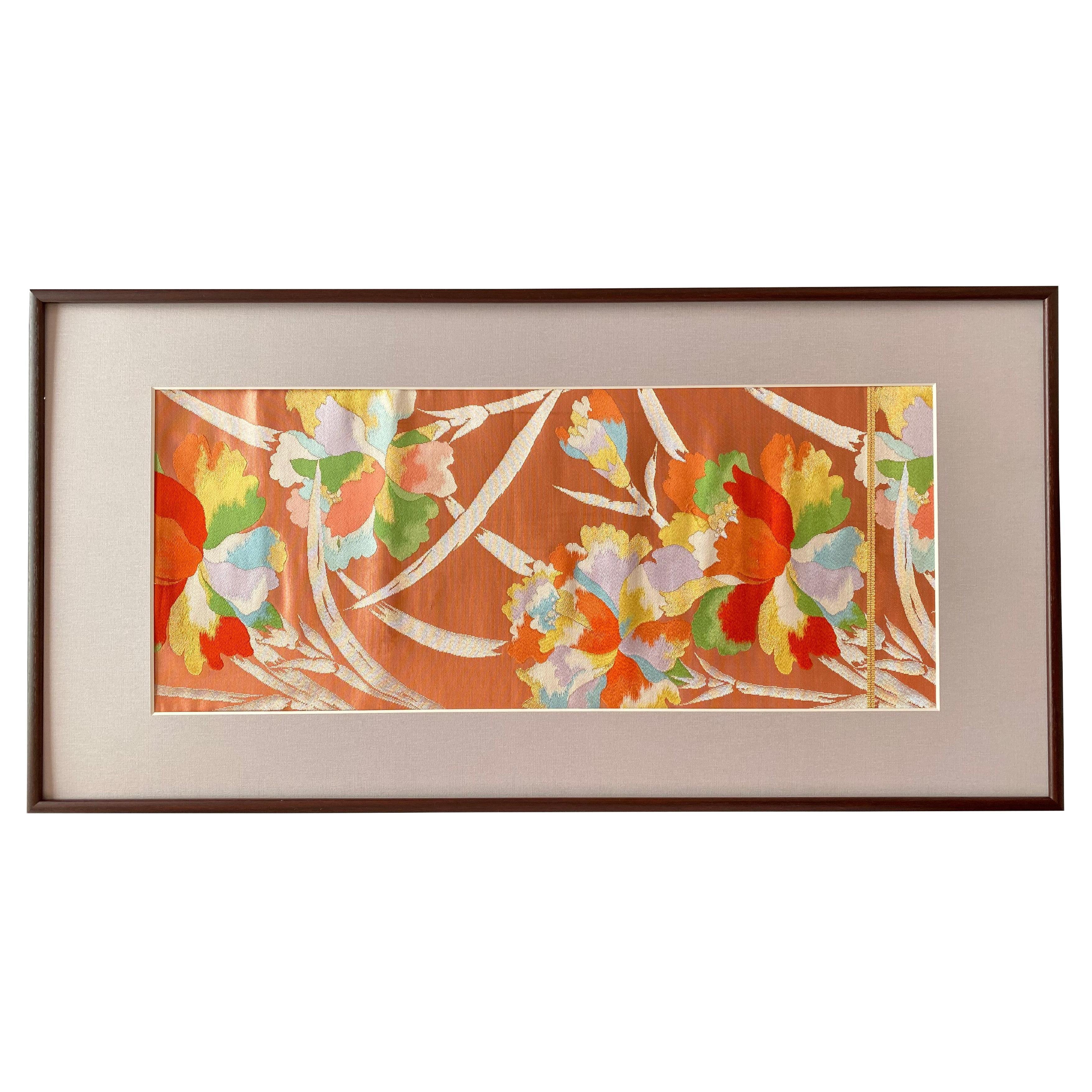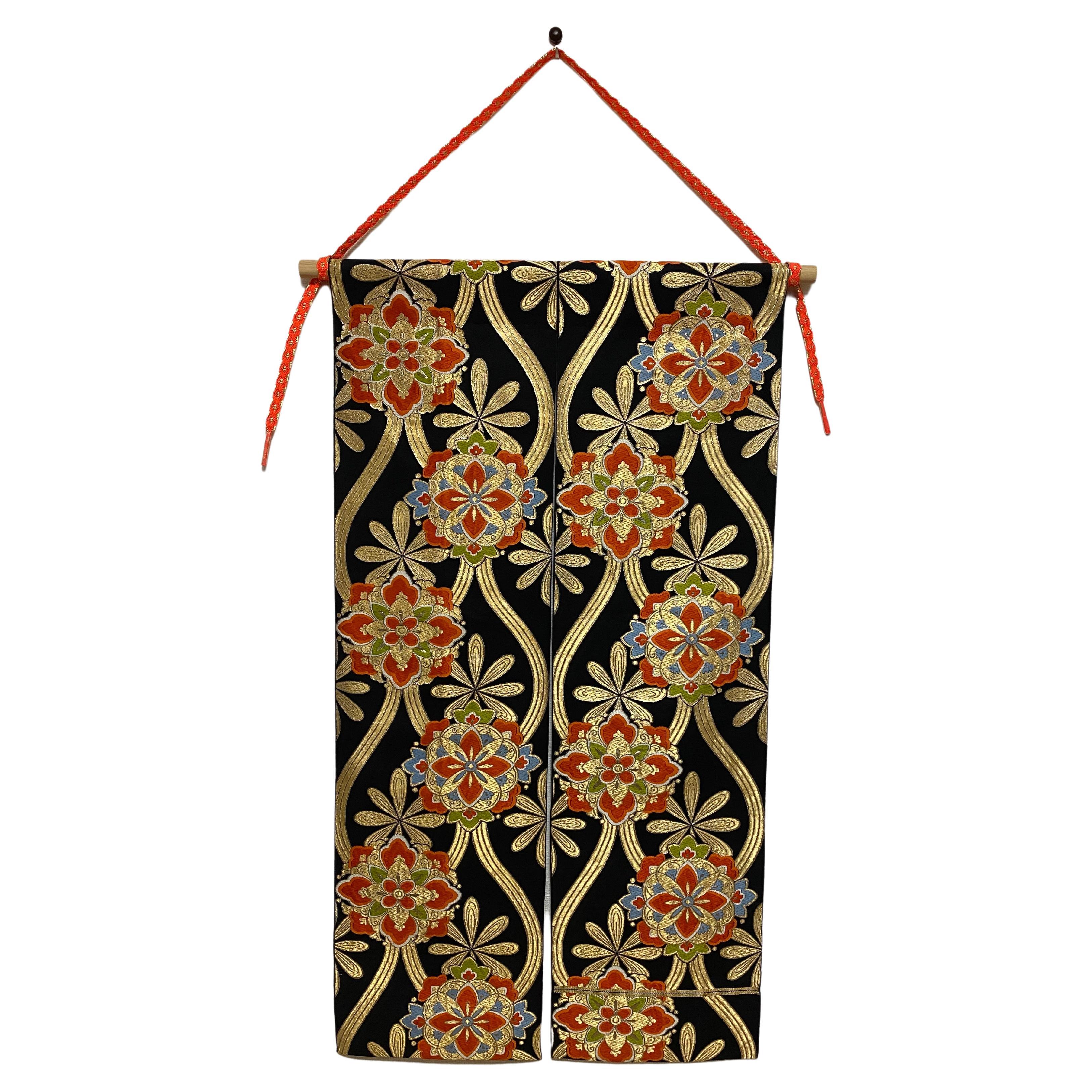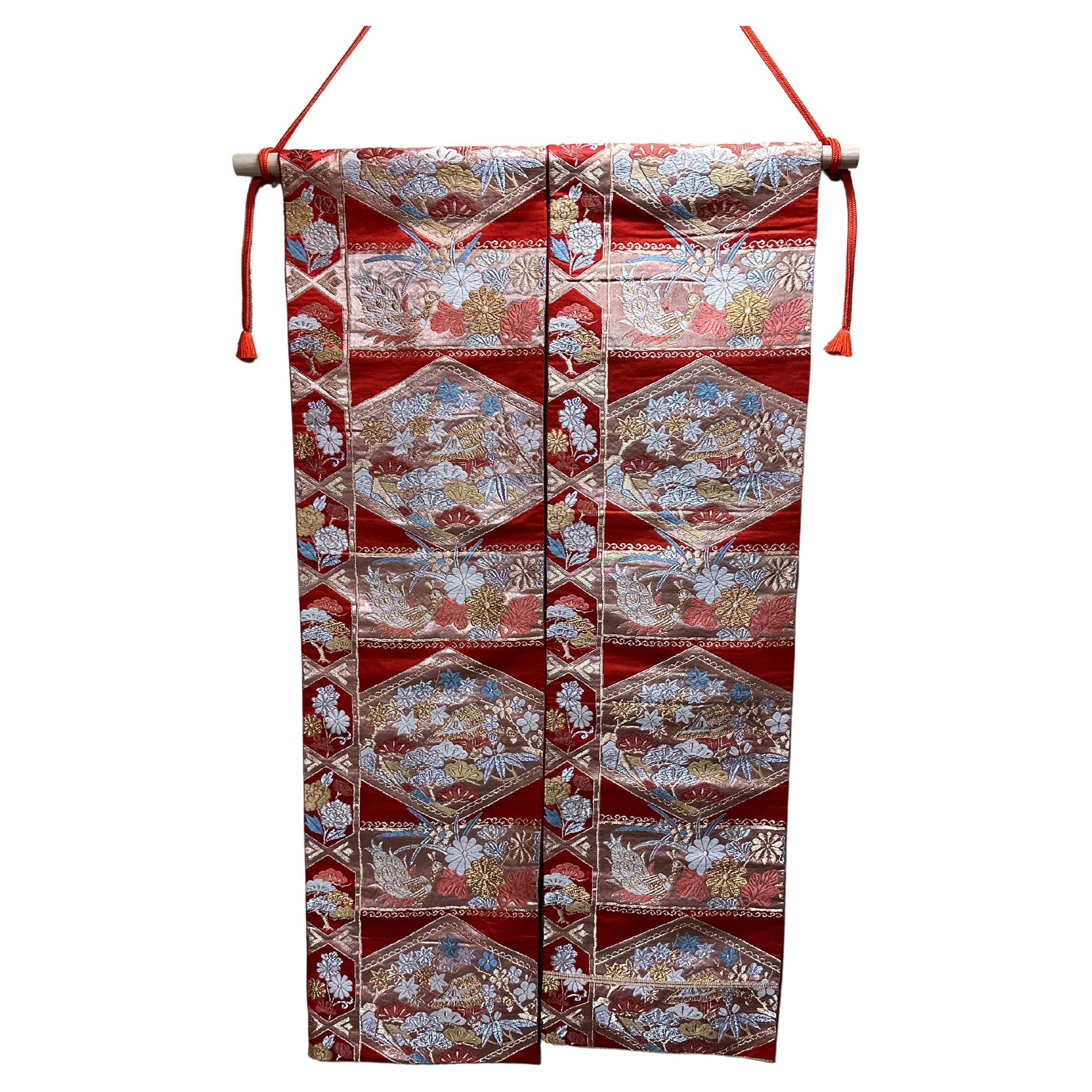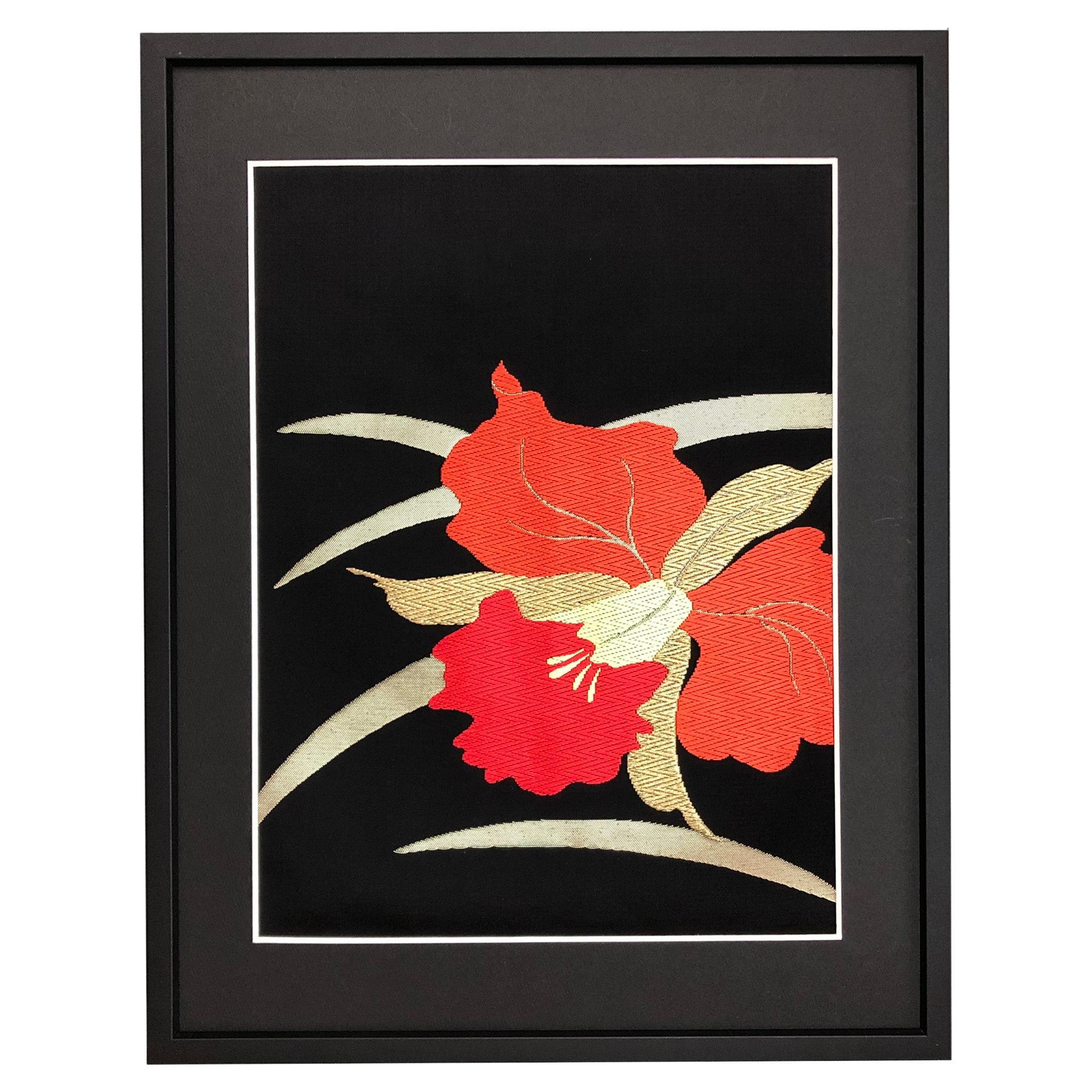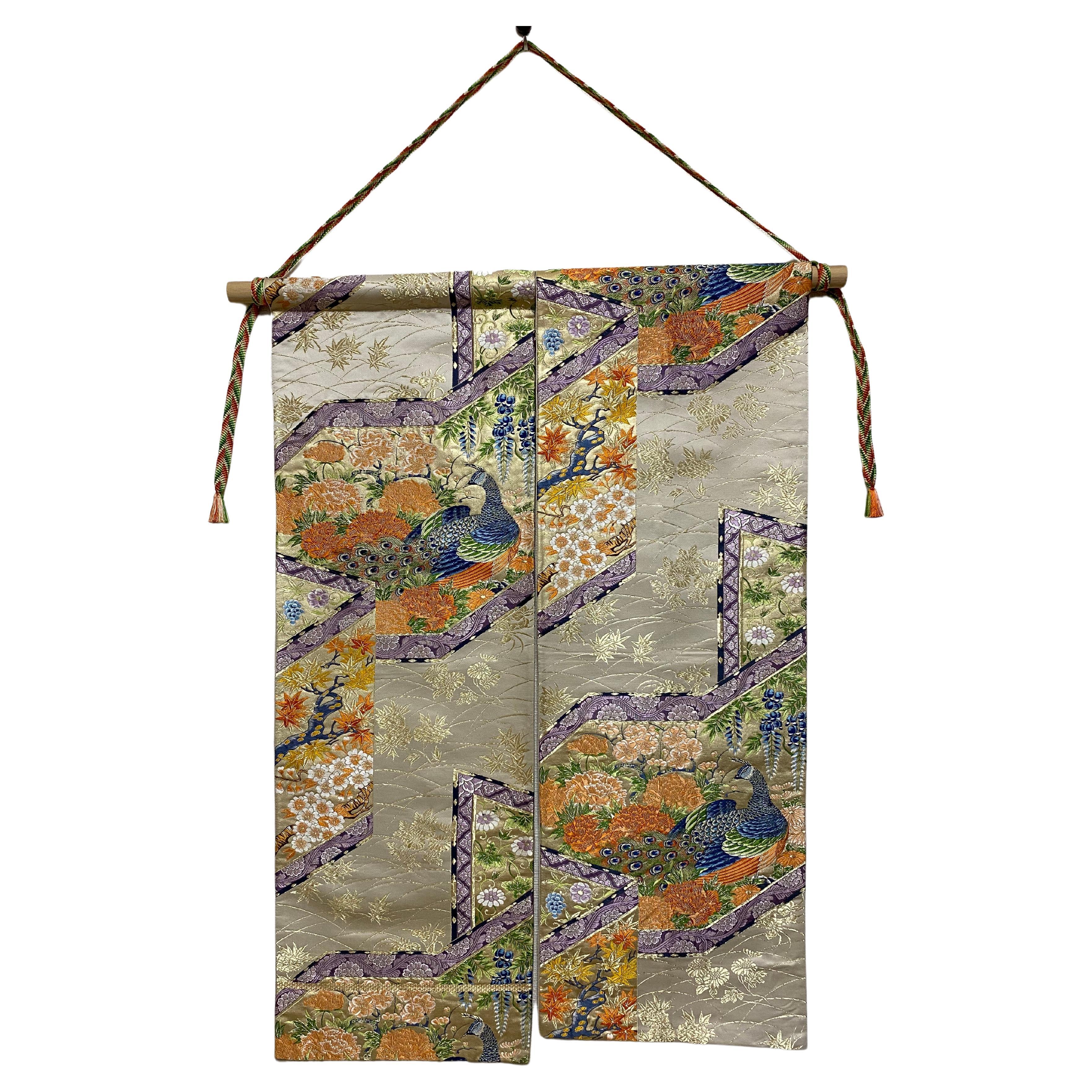Items Similar to 'Semi-Custom to Order' Japanese Kimono Art / Table Center, Coming of Spring
Want more images or videos?
Request additional images or videos from the seller
1 of 6
'Semi-Custom to Order' Japanese Kimono Art / Table Center, Coming of Spring
About the Item
This table Center is semi-custom to order. Within the length of the kimono obi(261cm), we will process it to match the desired table length at no charge.
The pattern that spreads over the entire obi is called SEIGAIHA, a pattern based on the motif of waves. It is a pattern that reminds us of the bounty of the wide ocean, and the pattern of endlessly expanding waves is an auspicious pattern that contains wishes for eternal happiness and a peaceful life for people. In addition, the waves are decorated with a detailed floral pattern, which adds a touch of glamour. You can see that this seemingly simple product has been carefully and delicately crafted.
We titled this product "Arrival of Spring". The warm, light pink silk fabric, the wave pattern that evokes a bright future, and the floral pattern that blooms gorgeously and delicately, all foretell of the arrival of spring.
We encourage you to use this carefully processed Kimono Obi as a table center for special parties and events.
If you have any other requests, we will do our best to accommodate them. Please contact us.
We sincerely wish you a wonderful spring with this product.
- Dimensions:Height: 102.76 in (261 cm)Width: 11.82 in (30 cm)Depth: 0.4 in (1 cm)
- Materials and Techniques:
- Period:
- Date of Manufacture:2022
- Production Type:New & Custom(One of a Kind)
- Estimated Production Time:Available Now
- Condition:Additions or alterations made to the original: Using Vintage Kimono Obi, Our skillful artisans wholeheartedly processed it into Kimono Art. Our artisans has been contributed in fashion industry for decades, and are well versed in Kimono. We're proud of our works and hope you enjoy it!
- Seller Location:Shibuya City, JP
- Reference Number:1stDibs: LU8102234004902
Kimono-Couture
Japanese Kimono Art by Kimono-Couture Kimono-Couture proudly creates one-of-a-kind Kimono Art using the highest quality Japanese-made obi. Japanese obi are meticulously crafted through countless intricate processes. We firmly believe that obi represent the culmination of Japan's world-renowned craftsmanship. However, as the culture of wearing kimonos has declined, opportunities to appreciate their beauty have significantly diminished. Therefore, at Kimono-Couture, it is our mission to share the splendor of Japan's traditions, culture, and sensibilities and contribute to the world of kimono culture through the creation of Kimono Art. At Kimono-Couture, our skilled artisans painstakingly examine every detail of each obi to bring out its maximum charm, including patterns, colors, and dimensions. Kimono Art conveys various wishes and meanings through its patterns and colors. For instance, the peacock pattern symbolizes "compassion," "abundance," and "health," while the crane pattern represents "vitality" and "longevity." Detailed explanations of the themes and beliefs behind each piece are available in the description section of our works, which we invite you to explore. We take immense pride in delivering our Kimono Art and your satisfaction is our utmost priority. We offer the option of customizing from your preferred patterns and colors, and we are also happy to suggest recommendations based on the wishes and meanings of Kimono Art. Please don't hesitate to contact us!
We will process it to your desired length free of charge and send it to you.
Please specify your desired length.
Due to the nature of kimono obi, please allow for an error of about 10 cm.
If you wish to have the length adjusted, please allow us time for processing.
We will do our best to meet your request as much as possible, so please contact us.
About the Seller
5.0
Vetted Seller
These experienced sellers undergo a comprehensive evaluation by our team of in-house experts.
Established in 2022
1stDibs seller since 2023
9 sales on 1stDibs
- ShippingRetrieving quote...Ships From: Tokyo, Japan
- Return PolicyA return for this item may be initiated within 7 days of delivery.
More From This SellerView All
- Japanese Wall Art / Kimono Art, Field of CarnationLocated in Shibuya City, Tokyo"Field of Carnation" by Kimono-Couture *Japanese Kimono Art *Handmade by Kimono-Couture *One-of-a-kind Japanese Art Using Japanese traditional kimono obi, our craftsmen have carefu...Category
21st Century and Contemporary Japanese Contemporary Art
MaterialsSilk, Thread
- Japanese Art / Kimono Art, Tate-Waku(立涌)Located in Shibuya City, Tokyo"TATE-WAKU" by Kimono-Couture *Japanese Kimono Art *Handmade by Kimono-Couture *One-of-a-kind Japanese Art This wonderful Japanese Art, made of venerable kimono obi...Category
21st Century and Contemporary Japanese Tapestries
MaterialsSilk, Thread
- Japanese Art / Kimono Art - Seasonal Flowers -Located in Shibuya City, TokyoJapanese Kimono Art by Kimono-Couture Title:Seasonal Flowers This Japanese Kimono Art is a one-of-a-kind wall art, painstakingly created by Japanese craftsmen. The bright pink color of this wall art is made from silk fabric, and the beautiful flowers of the Four Seasons are painted on the fabric. The beauty of the artwork can be appreciated by holding it in one's hands. The point we especially want to convey is the language of plum blossoms. Because of its dignified appearance in full bloom, the plum tree has long been loved in Japan for its meaning of elegance and integrity. The cool silver plum blossoms on a bright pink background give the impression of elegance and integrity. By decorating your room with this Kimono Art, you can experience the Japanese Four...Category
21st Century and Contemporary Japanese Contemporary Art
MaterialsSilk
- Japanese Kimono Art / Tapestry, LongevityLocated in Shibuya City, TokyoThis orange silk-based obi is decorated with a tortoiseshell l pattern. The tortoiseshell pattern was handed down from China during the Asuka period in Japan. During the Heian period , only aristocrats were allowed to use the pattern, and the general public could not even see it. Therefore, the tortoiseshell pattern is known as a sacred and prestigious pattern. The tortoiseshell pattern is a regular hexagonal pattern, derived from the shell of a turtle. The regular hexagon is said to be the most stable shape in nature, which means ""sturdy and strong. Today, it is also said to be a pattern that brings good luck in money. The tortoiseshell pattern is decorated with pine trees, bamboo, plum blossoms, and flowers of the four seasons such as chrysanthemums, daffodils, autumn leaves, and peonies. In Japan, the pine, bamboo, and plum trees have been a traditional Japanese good-luck charm since around the Edo period Pine trees are as long as 200 to 400 years old, and some are thousands of years old. Pine trees grow in harsh environments where other trees cannot thrive, and they are considered a symbol of vitality and longevity because of their year-round blue foliage. Bamboo is a symbol of prosperity of offspring because it grows straight and straight with new shoots. Because of its nutritional value, the plum tree played the role of a medicine against illness in ancient Japan. When a Japanese emperor fell ill, he ate...Category
21st Century and Contemporary Japanese Tapestries
MaterialsSilk, Thread
- KURENAI (Orchid) by Kimono-Couture, Japanese Kimono ArtLocated in Shibuya City, Tokyo"KURENAI" by Kimono-Couture *Japanese Kimono Art *Handmade by Kimono-Couture *One-of-a-kind Japanese Wall Art Kimono-Couture are proud to present this one-of-a-kind Japanese Wall Art, framed with vintage kimono obi...Category
21st Century and Contemporary Japanese Contemporary Art
MaterialsSilk, Thread
- Japanese Art / Kimono Art / Tapestry, the King of PeacocksLocated in Shibuya City, TokyoThis Kimono Tapestry, carefully and painstakingly embroidered by Japanese craftsmen, is the only one of its kind in the world. We are proud to present this tapestry, embroidered wi...Category
21st Century and Contemporary Japanese Tapestries
MaterialsSilk, Thread
You May Also Like
- Rare Spectacular Hand-Embroidered Silk Japanese KimonoLocated in Brea, CAThis highly collectable spectacular rare kimono has detailed hand-embroidery throughout accented . This ceremonial Japanese kimono is hand sewn and hand-quilted throughout.Category
Early 20th Century Chinese Chinese Export Antiquities
MaterialsSilk
- Embroidered Red and Green Japanese Silk Ceremonial Kimono, 1940'sLocated in Plainview, NYAn early 20th century exceptional Embroidered Japanese Ceremonial Kimono featuring marvelous handmade floral pattern in vivid colors including red, blue and green on gold. The interi...Category
20th Century East Asian Japonisme Textiles
MaterialsBrocade, Silk
- Meiji Period Red and Black Painted Kimono Storage Box, JapanLocated in Point Richmond, CAJapanese Kimono storage box, constructed of wood and bamboo, painted black with family crest painted in red on the sides. The top has wood slats, which ...Category
20th Century Japanese Meiji Sculptures and Carvings
MaterialsWood
- Fine Japanese Couture Shibori Silk Furisode Kimono with Under GarmentLocated in Atlanta, GAA spectacular Japanese silk kimono set with an outer furisode and an inner garment circa 1960-80s. The long sleeve furisode is of couture quality and made m...Category
Vintage 1960s Japanese Modern Textiles
MaterialsSilk
- Large Pair of Japanese Cloisonne Enamel Lanterns Attributed to Kaji TsunekichiLocated in New York, NYA Large Pair of Japanese Cloisonne Enamel Lanterns Attributed to Kaji Tsunekichi, Edo Period, 19th century Japanese cloisonne lanterns were made during the Meiji period, from the late 19th to early 20th century, and were often used as decorative lighting fixtures in temples and shrines. Kaji Tsunekichi (1866-1916) was a Japanese cloisonné artist who was active in the late 19th and early 20th centuries. He was born in Tokyo and learned the art of cloisonné from his father, Kaji Sataro, who was also a cloisonné artist. He was renowned for his mastery of the shippo-yaki technique, which involves creating intricate designs with thin wires on a metal base before filling in the spaces with enamel. Tsunekichi was known for his exceptional technical skills and his ability to create intricate designs with vibrant colors. His works often featured nature motifs, such as flowers, birds, and fish, which were rendered in a highly detailed and naturalistic style. He also experimented with new techniques, such as plique-à-jour, a type of cloisonné that creates a stained-glass effect. Tsunekichi's works were highly prized during his lifetime and continue to be sought after by collectors today. He won numerous awards for his cloisonné creations, including a Gold Medal at the 1900 Exposition Universelle in Paris. His works are characterized by their fine wirework, precise enamel application, and attention to detail. Some of Tsunekichi's most famous works include a pair of large cloisonné vases...Category
Antique 19th Century Japanese Edo Metalwork
MaterialsCopper, Enamel
- Large Pair of Japanese Cloisonne Enamel Vases Attributed to Honda YasaburoLocated in New York, NYA large pair of Japanese Cloisonne Enamel vases attributed to Honda Yasaburo, 19th century. Finley decorated with the rich enamel colors of orange and green, these vases are desig...Category
Antique 19th Century Japanese Meiji Metalwork
MaterialsCopper, Enamel
Recently Viewed
View AllMore Ways To Browse
Japan Kimono
Japaneses Kimono
Japanese Kimonos
Japanese Kimono
Light Pink Silk
Wave Of Japan
Japanese Decorated Table
Kimono Patterns
Kimono Pattern
Japanese Hand Warmer
Japanese Silk Embroidered
Japanese Art Ocean
Embroidered Kimono
Japanese Kimono Fabric
Arrival Of Spring
The Arrival Of Spring
Silk Embroidered Kimono
Pink Kimono
